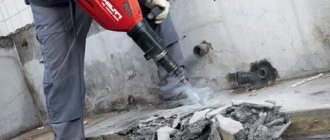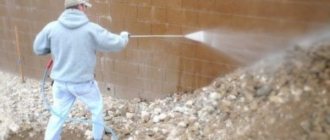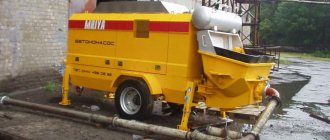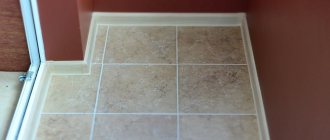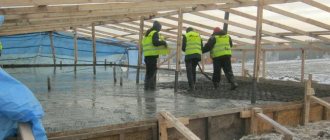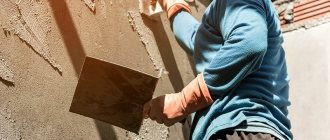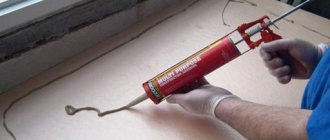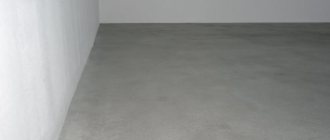How to Remove Oil Stains from Concrete
Oil or greasy stains on the concrete surfaces of paths, driveways or, as in my case, on the floor in the garage often become just an “eyesore.” Experience shows that no matter how hard you try, such troubles happen quite often - a seal leaked on a piece of equipment, or just spilled on negligence.
But the reason, in principle, is not important to us, something else is more important - let's decide how to remove stains from concrete, or at least try to do it. Why is it so difficult to remove oil stains? It’s simple - because of their rapid penetration into the surface of concrete.
Below is a comprehensive technique and some tips on how to deal with stains.
I’ll warn you right away before you start using anything to remove oil, you need to evaluate how it will affect the concrete itself and the surrounding clean surface, we don’t want to ruin everything.
So let's start cleaning up this one.
1 Remove all the oil from the surface The first rule is not to delay time, it plays against us.
The oil quickly penetrates the surface and then it becomes more difficult to remove it, so as soon as we see the stain we begin to prevent its spread. — You can first clean what is on the surface with paper towels or napkins, do not rub it over the area, but remove the excess with movements towards the center.
- Then you need to generously sprinkle the stain itself with dry sand, sawdust or just cat litter. After which you should wait a little, allowing the oil to be absorbed into the bedding. And then before removing the sand with a soft broom, place it back and forth so that the oil is better absorbed and then remove the dirty filler.
2 Let's move directly to oil removal products , these could be:
— Flushing, degreasing liquid for automobile engines — Washing powder with high foaming — Concentrated liquid detergent
Tips: - These products are more effective when applied with hot water. — You need to work with a hard bristle brush.
Methods for removing oil from concrete
In production conditions, the solution to the question of how to remove oil from concrete is carried out at the level of engineering services. There should be no handicraft or folk methods if large quantities of oil stains accumulate on concrete surfaces of highways, airfield runways, in production workshops, warehouses, service stations, etc.
It is impossible to clean such huge areas, kilometers of roads efficiently and quickly using the old proven method.
- Proven method. An oily stain, if it is fresh, is covered with sand, caustic soda or cement. The bulk substances absorb the oil, and then you need to sweep everything away. An old oily stain on concrete is washed off with a solvent (solvent, white spirit, etc.) or a solution of detergents. Disadvantages of the simple method: oil can only be removed in a limited area; high costs of materials, technical and human resources; solvents and detergents pollute the environment; It is impossible to completely remove oil from concrete.
- Modernized method. We invite you to look at the latest products from the chemical industry. Scientists have long studied the structure of oil substances and have developed a formula for a product that breaks down oil molecules of any origin (natural or synthetic). A special product for removing oil from concrete acts quickly and efficiently. Large areas can be cleaned with minimal expenditure of funds and financial resources.
Review of effective solvents.
We'll tell you which concrete and cement solvents have won the trust of Russian builders. The selection is based on average cost, effectiveness, safety and a number of other parameters.
| Name | Description of the solvent | special instructions |
| "Lepta Himfrez" | Designed for cleaning brick and concrete surfaces from limescale, cement laitance and concrete contaminants. | Work at a temperature not lower than 5°C. Subsequent sandblasting is allowed. Consumption 2-4 l/m2. |
| "BIO DECAP'BETON GUARD" | Can be used as an alternative to products containing phosphoric acid. Designed for cleaning tools and equipment from cement deposits. | Shake the canister before use. The composition cannot be diluted. The solution is applied using a sprayer, first to an inconspicuous place. |
| "Barracuda 10K" | Used to clean concrete from any surface, including tiles and bricks. Also suitable for cleaning tires, car paintwork, etc. Does not contain acids. | It is prohibited to use an AED for application. Not recommended for use on chrome surfaces or for cleaning low-quality stainless steel products. |
| "Lugato Zementschleier entferner" | Dissolves cement and limescale. Can be used to clean plumbing fixtures, including bathtubs. | It is prohibited to wash marble and related materials. |
| EK 100 “Super” | Dissolves any cement-based building compositions. Can be used to clean construction mixers. | It is diluted in proportions based on its intended purpose. |
| "Divinol Betonloeser" | Topical concrete solvent for cleaning construction equipment and tools. | Do not use on aluminum, brass or copper surfaces. |
To protect metal tools, equipment and formwork, you can use solvent B 100 T (HWR B-100). It creates a microfilm on the surface and reduces the adhesion of cementitious compounds to various surfaces. After use, the instrument can be washed with plain water to remove any remaining product.
Concrete is a durable and versatile material. This is the basis and standard of flooring. Often concrete floors are left without additional finishing. Concrete flooring can be smooth or rough, and can be uniquely designed or painted.
Whatever type of concrete it is, in order to constantly keep it clean and increase its durability, it is necessary to properly monitor it.
In this article you will learn how to clean a concrete floor. It doesn't matter whether it's a floor in your home or office, whether it's outdoor or indoor, if you follow these instructions, your floor will last you a long time.
In our company you can order cleaning after the renovation of your apartment.
How does the process of removing oil from concrete work?
- You need to choose a special liquid to remove oil from concrete. Such products are sold in specialized stores. You can see the list of products on our company website. You need to study the instructions to determine the amount of liquid needed to clean large production areas.
- Oil stains on concrete are covered with a special solution from a spray bottle. The solution can be added to water for a car that washes roads. The concentrated liquid breaks down fatty compounds in 1.5 minutes.
- The remains of the oil splitting process in the solution must be collected with a special vacuum cleaner and washed off with water. We get a clean concrete surface without any oil stains.
Where does motor oil come from on concrete?
- First of all, the appearance of engine oil stains indicates a malfunction of the engine and related units. The seals leak and oil drips onto the concrete.
- Engine oil is changed periodically in the engine, so it can spill when changing.
- Drops of oil fly out along with the exhaust gases when the engine is running.
In any case, the oil stain that appears must be removed from the floor to stop contamination of the area. How to wash off motor oil from concrete so that the stain does not appear again is recommended by specialists - chemical product sales managers.
What methods are used to remove motor oil from concrete?
Method 1 . Wash off the concrete under high pressure of water. Wipe off oil stains with a brush. Of course, it will not be possible to completely remove the oil, but any debris stuck to it will disappear.
Method 2 . Rinsing with a detergent that breaks down fats. It is advisable to apply the product directly to oil stains, and then rinse under running water using a washing machine.
Method 3 . Apply an organic solvent (for example, white spirit) to oil stains, leave for a while, and then rinse with water using a stiff brush. Dried layers of oil cannot be removed this way. Only fresh motor oil stains will be washed away.
Method 4 . Using multi-purpose chemicals that break down the oil compounds in thick accumulations of oil and dirt on the floor, penetrating deep into the pores of the concrete, removing the oil stain completely.
Video material
In this article, we have shared with you the most popular and effective ways to get rid of unpleasant construction stains on a car without damaging the top layer of paint. All of them have been repeatedly used by many motorists, so there is no doubt about their effectiveness. We sincerely hope that with the help of these recommendations you will be able to quickly and easily return your vehicle to its former cleanliness and attractiveness.
How to remove oil from concrete - 3 ways to remove greasy stains
The concrete surface is not perfectly smooth and has pores. Detergents in concrete are used to clean the surface. If the material on top is not treated with a sealant, then various substances, paint and other chemicals can get into it, resulting in oil stains. Often engine oil gets deep into the floor in production workshops, auto repair shops or storage facilities, which can lead to fire hazards. Therefore, it is important to know how to remove such contaminants from concrete.
Preparation of concrete floors: mechanical cleaning
Stages of concrete floor repair: preparing the floor for repair, applying cement to the crack.
To properly prepare a cracked concrete floor for the intended repair, it must first be cleaned of loose and loose pieces. To do this you will need the following tools:
- Wire brush.
- Chisel.
- Hammer.
- Brush or broom for sweeping.
Work to prepare a concrete floor for repairs is carried out in the following order:
- Cracks are treated with a wire brush to remove loose pieces.
- The problem area of the floor is thoroughly swept.
- The edges of the cracks are tapped with a hammer to identify places where there are hidden defects.
- Using a chisel and a hammer, cracks are repaired (defective edges and fragments are removed).
The further sequence of actions depends on the size of the embroidered cracks. If their number is small and their depth is no more than 5 cm, then mechanical cleaning of concrete floors can be done. In this case, the last step in preparing concrete floors for repair will be to cover the cracks with a special compound. This is done in order to strengthen adhesion (gluing) between the old floor covering and the concrete patch. Typically, 3 types of compositions are used:
If dirt has become embedded in the concrete, it can be cleaned chemically or mechanically. If cracks have formed, they need to be patched.
- Acrylic primers for concrete.
- PVA primers.
- Epoxy compounds.
It should be noted that acrylic and PVA primers differ in the method of application from epoxy compounds. The first ones are applied exclusively on dry concrete. Filling potholes is done only after the primers have dried. However, if epoxy compounds are applied during repairs, the concrete must first be wetted. The patch is applied over potholes before the epoxy dries. Acrylic and PVA primers can be applied in two layers: this improves adhesion. Primers can be applied with a brush or roller.
Return to contents
Methods for removing stains
Oil drips create a sticky, greasy layer on which dirt constantly sticks. If a puddle is noticed immediately, it can be removed before it penetrates deeper. To do this, use soda, sand or cat litter. All these substances are absorbents that absorb pollutants. After pouring the product, you should press it down well with a stone or any heavy object for faster absorption. After a short period of time, the remains are removed. However, this method is not very effective.
Methods for eliminating oil stains from concrete
Mechanical cleaning
This cleaning method is used almost without exception. It is unacceptable to use it in food industry warehouses or premises with increased cleanliness requirements. It should be remembered that the top layer is damaged during such cleaning. The mechanical type of cleaning is divided into subtypes:
- grinding;
- sandblasting;
- hydro jet polishing.
Grinding concrete surface
Using this process, the top layer of concrete along with the contamination is cut off. To do this, use a diamond-coated tool of a mosaic grinder. There are 2 types of such processing: dry and wet. Dry processing raises a lot of cement dust, but all the shortcomings are easily visible in the process. Therefore, they are easy to fix immediately. Wet grinding is carried out using abrasive components and water. An important feature is that during work it is necessary to use water pumps to remove excess moisture from the working surface. As a result of removing the top layer, wet cement slurry is formed. It is difficult to immediately assess the quality after a washed floor; you need to wait until it dries completely.
Sandblasting
Sand acts as an abrasive, which, under high air pressure, falls on the elements being processed, thereby removing foreign components or low-quality concrete particles. This treatment has many advantages, since no water or high temperatures are used during cleaning, and there is no physical pressure on the surface. After this process, you can immediately apply paint or other substances on top, since the top layer does not need to be dried.
Approved supplied air respirators must be used during abrasive cleaning. Inhaling dry or wet pollutants is strictly prohibited by the Ministry of Health; this is dangerous for the respiratory system.
Hydrojet removal of oil stains
Construction project managers call pressurized water jetting a universal solution for cleaning concrete surfaces. The water pressure in the process varies depending on the type of contamination: rust, oils, paints that peel off. Surfactants are added for effective cleaning. After treatment, rinse the floor again with clean water. Removing oil stains from concrete using sediment is considered the optimal solution, since it does not destroy structural elements, but only removes contaminants. To fill the pump, tap water is used, which indicates low cleaning costs.
Chemical cleaning agents
Chemical cleaning involves treating oil stains on concrete with special compounds. Mostly cleaning companies do this type of cleaning. On sale you can find non-toxic and multi-component compositions that can remove stains of any composition and volume. To remove oil stains from concrete surfaces, cleaning representatives recommend using DOCKER MAZBIT TURBO. The cleaner is based on alkali, which guarantees the safety of the concrete surface. As a result of the reaction with the components, the pores of the concrete open, allowing the application of insulating layers with deep penetration. A sorbent is often used to remove contaminants, which binds oil, fuel and hydrophobic (water-repellent) chemicals. The product can simply be flushed down the drain for general cleaning at a wastewater treatment plant. When disposed of, it burns without leaving any residue.
Concreting floor cracks
To complete this stage of repair you will need the following tools and auxiliary materials:
Scheme for repairing a crack in a seam.
- Ready frames for cracks.
- Container for mixing cement-sand mixture.
- Sandpaper (coarse grain).
It should be noted that frames for cracks are usually made of wooden slats, with edges no larger than 2 cm. The dimensions of the frames should be 2-3 cm larger than the dimensions of the cracks on each side. The process itself will not take much time. First, the cement-sand mixture is mixed. As a rule, the ratio of cement and sand is either 1:3 or 1:2. A 1:3 mixture is used in cases where additives are added to the cement to increase the wear resistance of the mixture. However, if you do not plan to use additives or plasticizers, it is better to choose a cement to sand ratio of 1:2.
The cement itself must be grade M400 or M500, otherwise the patches on potholes will not last long.
When mixing the mixture, pay attention to the details. It is advisable to choose fine- or medium-fraction sand, clean, without lumps and random large fragments. The water for mixing the mixture must also be clean, without the slightest impurities, as they lead to cracks in the installed patches. However, you should not add too much water: the patch mixture should not run off the shovel, but fall off it in large fragments.
To ensure that the repaired floor lasts a long time, reinforcing elements such as fiberglass or fiberglass can be added to the patch mixture. Both 900 g and 600 g fiber packs are available for sale, so purchasing a small amount of fiber will not be difficult. When reinforcing fibers are added to the cement-sand mixture, the service life of the patches, their abrasion resistance and impact resistance increase significantly. In addition, a plasticizer (complex additive) can be added to the mixture. For example, M5Plus, which combines well with reinforcing fiber and improves the wear resistance of patches. The sequence of work when applying patches during repairs is as follows:
- Installation of the frame.
- Applying cement to the area of cracks.
- Removing the protruding upper part of the patch using a grinder (grinder) or sandpaper.
Removal of the protruding part of the patch should be done only after the cement has completely set. Considering that the thickness of the patch is relatively small, it is quite enough to wait 7 days and then process the patch with a grinder or sandpaper.
After the DIY floor repair is completed, you can go over the floors with compounds that help protect the concrete from corrosion. This procedure is called concrete dust removal. Thin-layer protective compounds (Elanor-PU, Neomer-LP, Amphor-formula) and polymer protective compounds (Retroplay, Elanor-ED Grunt, Elast-Pu) are used for it. All of them are applied with a brush in 2 layers. Dust removal will help further increase the service life of repaired concrete floors. If desired, the supplied patches can be even more durable than the base on which they are placed.
Careless builders cause a lot of trouble, one of which is concrete contamination. This material has good adhesion to metal, brick, stone and therefore is very difficult to remove. If metal tools can be washed with a high-pressure apparatus, then with finishing materials everything is more complicated.
